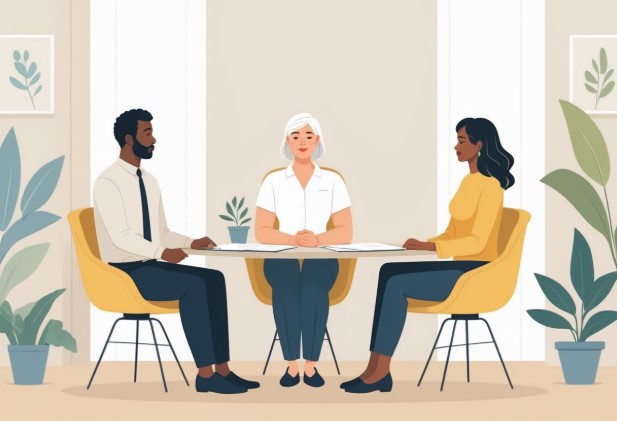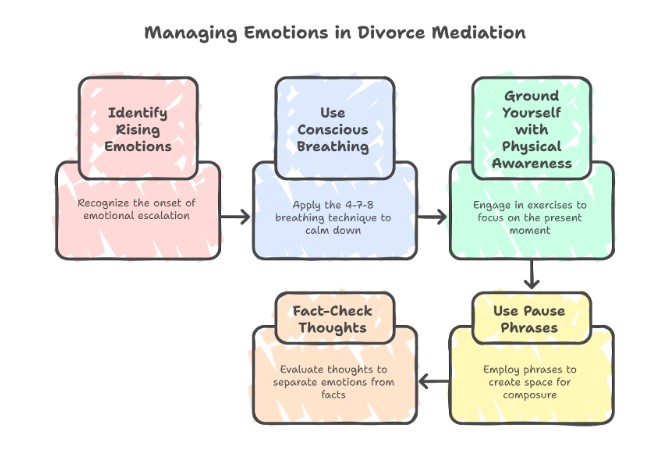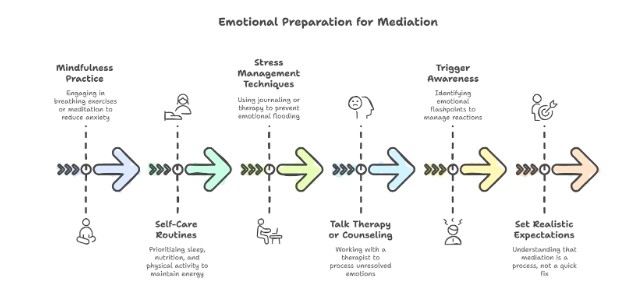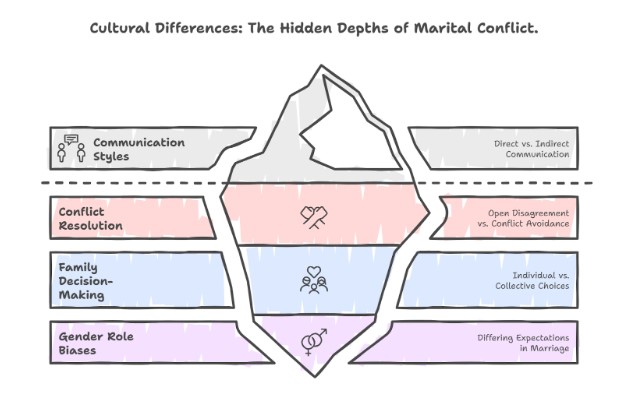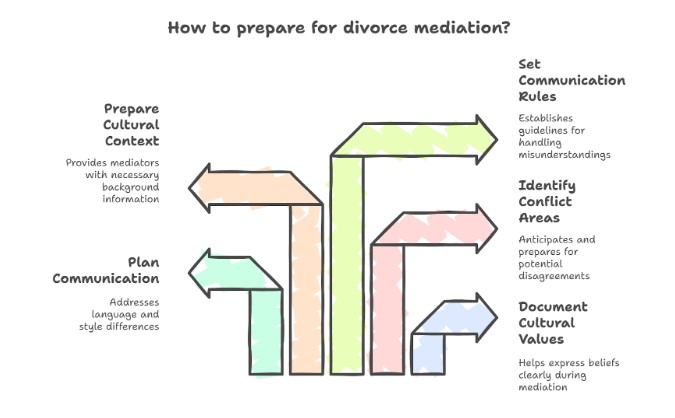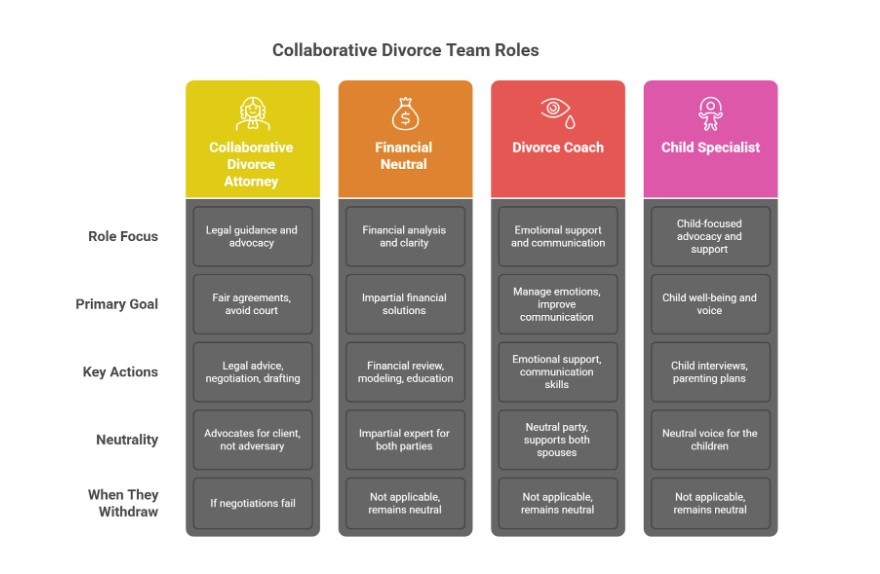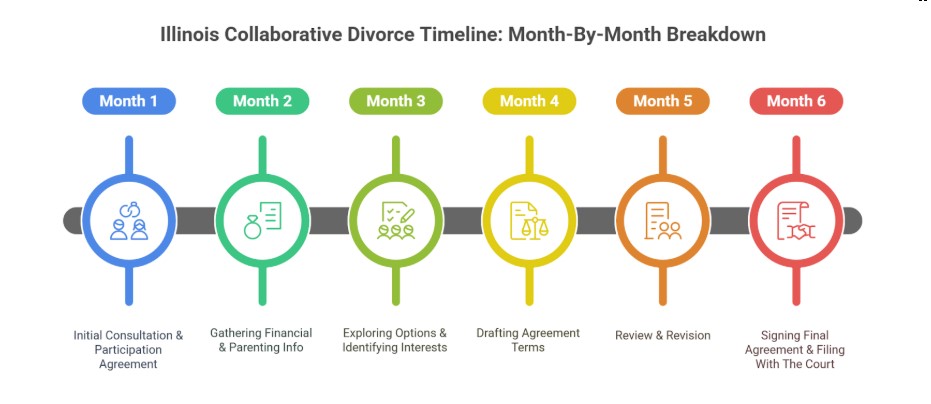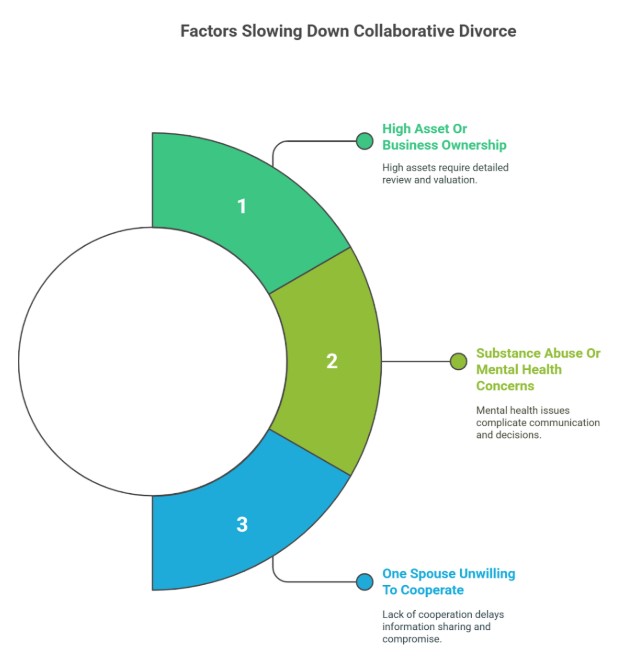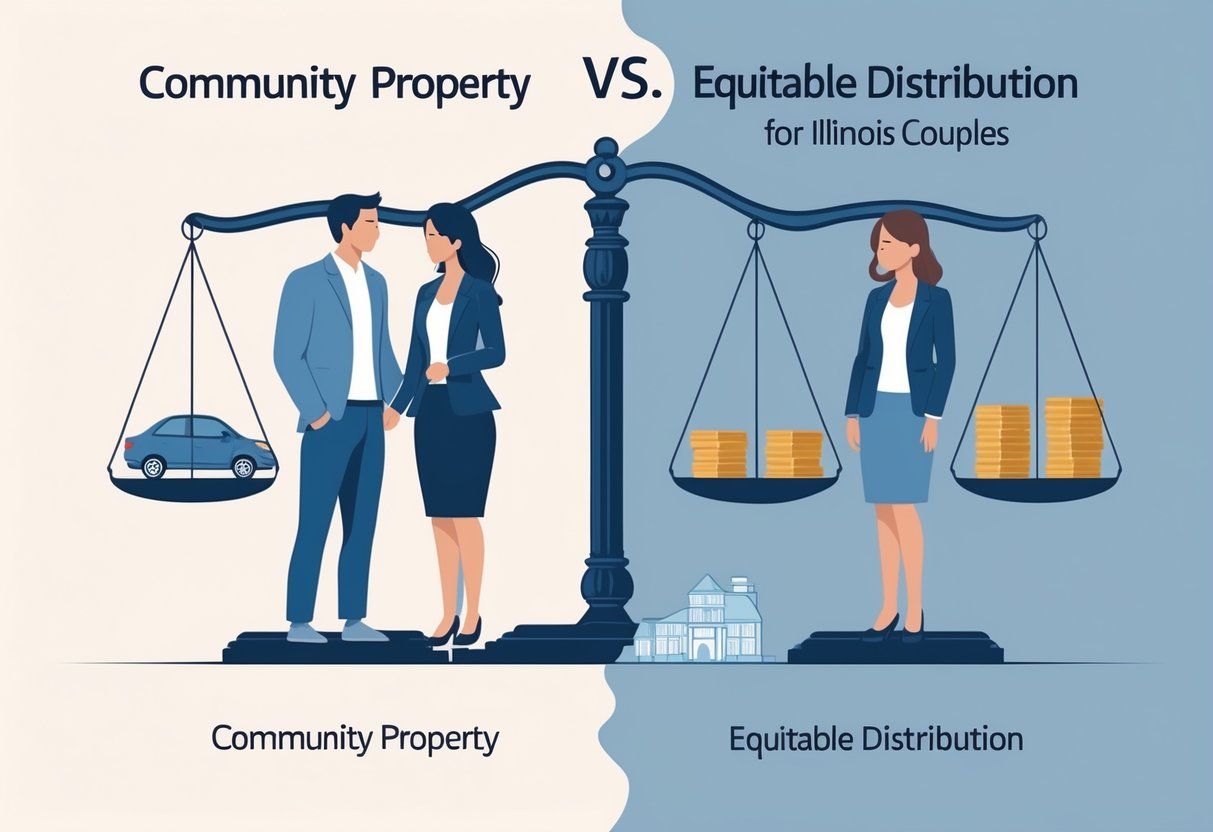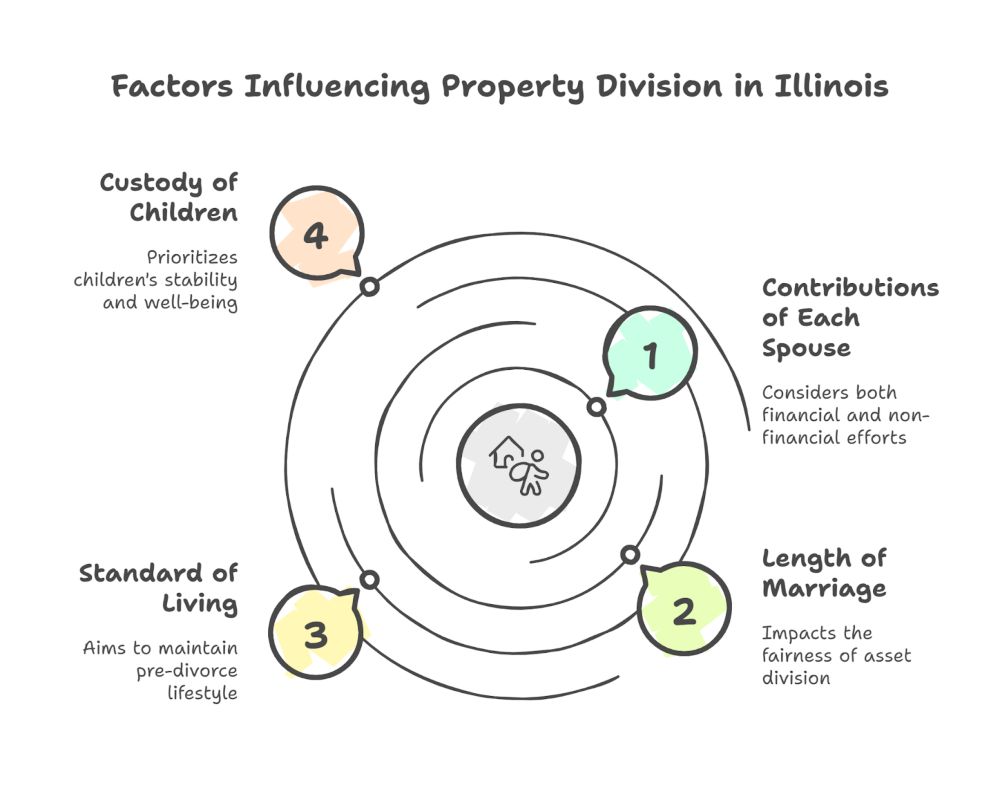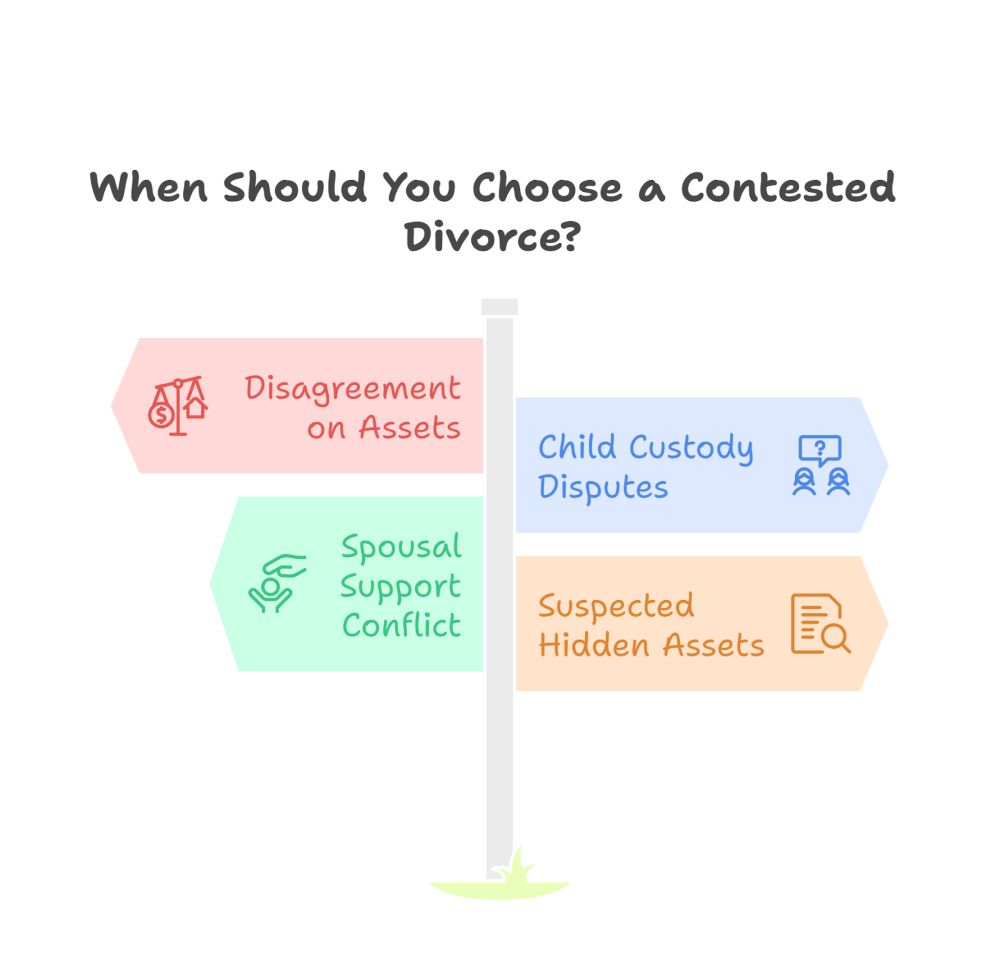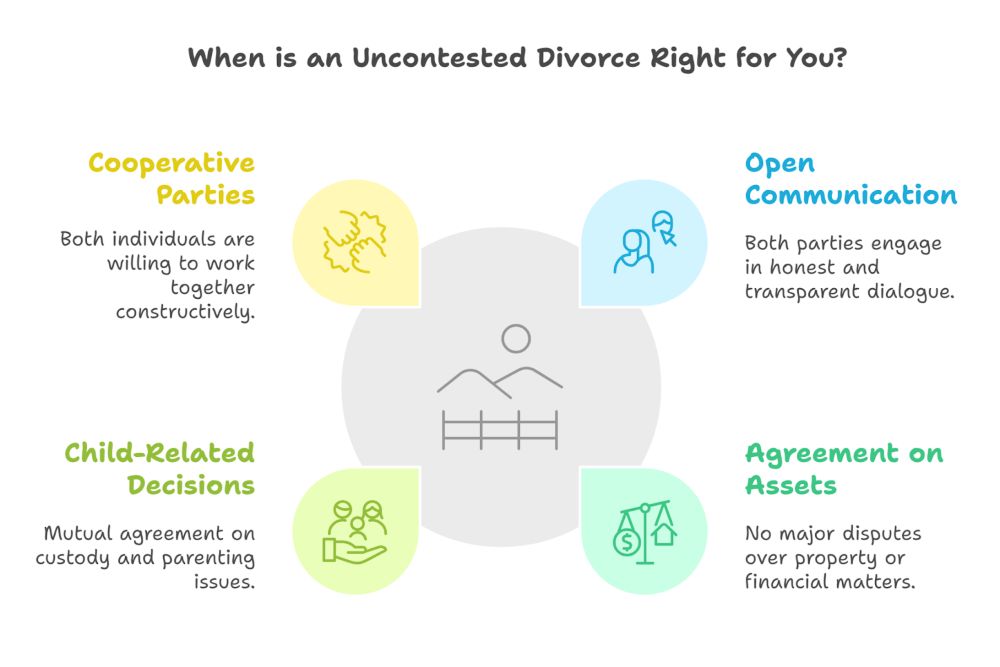Divorce mediation can feel like a mountain when emotions run wild and talking just falls apart. Most couples arrive at mediation barely able to hear each other above the noise of their pain and frustration.
Active listening techniques turn divorce mediation from a tense standoff into a collaborative problem-solving space, leading to outcomes everyone can live with.
The gap between just hearing someone and truly listening? It comes down to a few specific techniques that help divorcing spouses get where the other is coming from.
Active listening means giving your full attention to your spouse’s thoughts and feelings, creating a safe space for honest conversation.
Let’s be real: nobody finds these skills easy when you’re having emotional talks about ending a marriage.
Learning some proven listening strategies before you step into mediation can save you a significant amount of time and headaches. Mediators notice when people use these skills, and honestly, it’s often the difference between a session that works and one that just drags on.
If you approach listening the right way, you can move from blame and defensiveness toward solutions that protect your kids and your peace of mind.
Key Takeaways
- By focusing on understanding rather than reacting, couples can communicate more calmly and move through mediation more efficiently.
- These listening tools help both parties feel heard, which increases cooperation and leads to better outcomes.
- Interrupting, defensiveness, and dismissive language are common communication blockers during divorce mediation.
- Practicing empathy and clarity during mediation lays the groundwork for healthier communication after the divorce is finalized.
What Is Active Listening In Divorce Mediation?

Active listening in divorce mediation is about truly tuning in to your spouse’s words and emotions to foster genuine understanding.
This skill can transform heated arguments into meaningful conversations that lead to mutually beneficial agreements.
Active listening is way more than just hearing what’s said. It’s composed of a few key elements that work together to facilitate genuine communication.
Paraphrasing is when you restate what your spouse said, but in your own words. It shows you got the gist, and gives them a chance to correct you if you missed the mark.
Say your spouse says, “I’m worried about the kids.” You might reply, “So you’re concerned about how this divorce will shake up their routine?”
Empathy is about seeing and acknowledging your spouse’s emotions without jumping to judge. You don’t have to agree, but you can still show you get how they feel.
If someone’s venting about money stress, you might respond, “I can hear that you’re anxious about making ends meet.”
Non-verbal cues include your body language, facial expressions, and tone. Sometimes these say more than your words ever could.
Leaning in, making some eye contact, and keeping your arms uncrossed? Those all show you’re engaged. Try to maintain a steady and calm tone—even when things get tough.
How Active Listening Differs From Passive Hearing
Let’s be honest: most people think they’re listening, but really, they’re just waiting for their turn to talk. Passive hearing is just being in the room while you secretly plan your comeback.
Passive listeners cut in, finish sentences, or jump right into defending themselves. They care more about winning than understanding the game.
Active listeners do things differently. They ask questions like, “Can you help me understand what you mean by that?” They pause before replying and reflect on what was said.
Key differences include:
- Passive: Planning your rebuttal while they speak
- Active: Focusing completely on their message
- Passive: Interrupting to correct or disagree
- Active: Waiting for them to finish before responding
- Passive: Dismissing emotions as irrelevant
- Active: Acknowledging feelings as valid information
Why Listening Matters More Than “Being Right” In Mediation
Divorce mediation only works when you aim for real understanding, not just hearing words. If both spouses become fixated on being right, you end up with an adversarial vibe and little to no compromise.
Active listening flips things around. When people feel heard, they’re way more open to creative fixes.
This approach also helps you determine what’s truly behind your spouse’s demands. Maybe they want the house not because they adore it, but because they crave stability for the kids.
Benefits of prioritizing listening:
- Less defensive reactions
- More creative solutions on the table
- Trust builds—slowly, but it happens
- Minor misunderstandings don’t explode into big fights
Research supports this: couples who actively listen tend to reach agreements more quickly and feel better about the outcome.
Quick Checklist: Are You Actively Listening?
Try this checklist in your next mediation session to see how your listening stacks up:
Before you respond, ask yourself:
- Did I let them finish speaking completely?
- Can I repeat back what they said in my own words?
- Do I understand the emotion behind their words?
- Am I staying calm and keeping an open posture?
- Did I ask questions to clarify unclear points?
Warning signs you’re not listening:
- You’re thinking about your response while they speak
- You feel the urge to interrupt or correct them
- You’re focused on proving them wrong
- Your body language appears closed off or defensive
- You dismiss their emotions as unreasonable
Good active listening looks like:
- Paraphrasing their main points before sharing your view
- Asking “Help me understand…” when confused
- Acknowledging their feelings, even when you disagree
- Taking brief pauses before responding to process what you heard
- Using phrases like “I hear you saying…” or “It sounds like you feel…”
Benefits Of Active Listening During Mediation
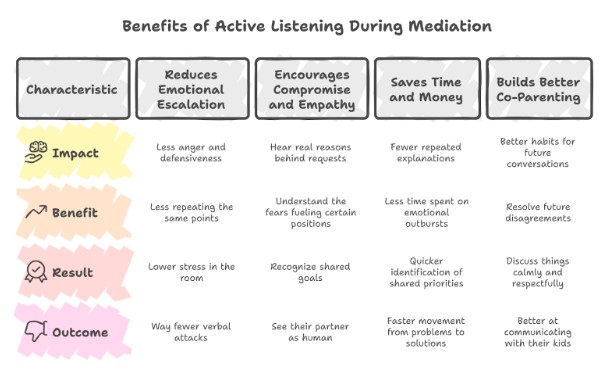
Active listening brings real improvements to divorce mediation. It reduces conflict, fosters trust, and enables mediators to run more productive sessions.
These communication skills make a significant difference in both the emotional atmosphere and the actual results you achieve through mediation.
Reduces Emotional Escalation
Active listening cools things down by showing each person that their worries are heard and matter. When people feel validated, they’re less likely to get defensive or start shouting.
This technique allows emotions to be expressed without immediate judgment or pushback. One spouse can vent, and the other just listens—no interruptions, no plotting a comeback.
Key emotional benefits include:
- Less anger and defensiveness
- Less repeating the same points over and over
- Lower stress in the room
- Way fewer verbal attacks
Mediators often observe a shift in mood when both parties agree to listen before jumping in. It’s a simple change, but it keeps countless arguments from spinning out of control and wasting everyone’s time.
Encourages Compromise And Empathy
Active listening helps people bridge the gap between different views. When you listen to your spouse’s concerns about custody or money, you might spot valid points you never thought about.
It doesn’t mean you have to agree on everything. But it opens up space for solutions that work for both sides.
Empathy grows when spouses:
- Hear the real reasons behind requests
- Understand the fears fueling certain positions
- Recognize shared goals, like looking out for the kids
- See their partner as human—not just an opponent
Constructive dialogue can finally happen when both people feel heard. Sometimes, spouses even surprise themselves by offering compromises they never would’ve considered before.
Saves Time And Money By Streamlining Decisions
Active listening stops those endless cycles that drag out mediation. When people feel heard the first time, they don’t have to keep repeating themselves.
Sessions move faster because everyone’s energy is focused on finding solutions, rather than fighting to get their point across. Spouses can check off agenda items more quickly when communication works.
Time-saving benefits:
- Fewer repeated explanations of the same concerns
- Less time spent on emotional outbursts
- Quicker identification of shared priorities
- Faster movement from problems to solutions
The financial savings add up fast since most mediators charge by the hour. Couples who improve their listening skills often complete their divorce mediation in fewer sessions than those who struggle with miscommunication, as effective listening can help resolve conflicts more efficiently.
Builds Groundwork For Better Co-Parenting Communication
The listening skills acquired in mediation don’t just disappear when the divorce is final—parents who actively practice listening during their split start building better habits for future co-parenting conversations.
Couples with children often stay connected for life, so these skills are particularly important. School events, medical matters, and schedule changes—they all require ongoing cooperation.
Children benefit when parents can discuss things calmly and respectfully. The conflict resolution skills learned in mediation help parents resolve future disagreements without involving the kids or resorting to court.
Some parents even say learning to listen during mediation made them better at communicating with their kids, not just with each other.
Navigating divorce isn’t easy, but clear communication can make it smoother. Anna Krolikowska offers personalized divorce mediation that puts your voice first. Schedule your consultation to begin the process today.
7 Proven Active Listening Techniques For Mediation
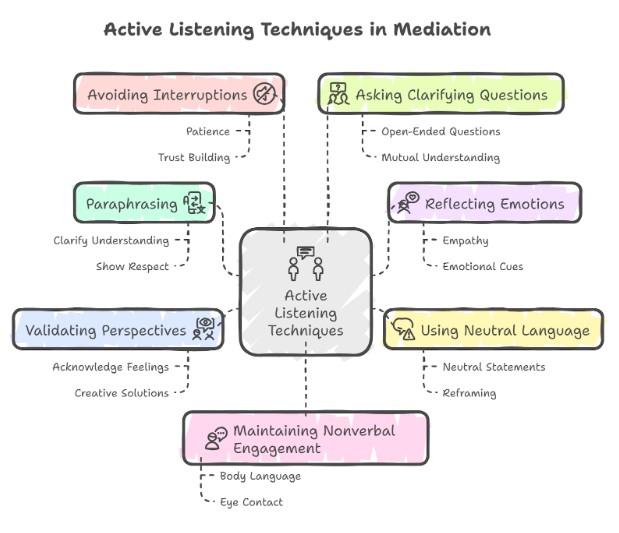
These seven techniques help mediators build trust and guide couples toward mutual understanding. Each method aims to create a space where both individuals can feel heard and respected—no matter how challenging the conversation becomes.
1- Paraphrasing To Clarify Understanding
Paraphrasing means restating what someone said in your own words to make sure you’ve got it right. This indicates that you were attentive to the speaker. It also gives them a chance to clear up any mix-ups right away.
Good paraphrasing isn’t just repeating. The mediator grabs the main idea and reflects it in simpler terms. That way, both sides can see their concerns more clearly.
Example paraphrasing phrases:
- “What I hear you saying is…”
- “It sounds like you feel…”
- “Let me make sure I understand…”
The point is to show the mediator gets each person’s perspective. When people feel understood, they tend to listen more attentively as well.
This lays the groundwork for effective mediation communication and problem-solving. Paraphrasing also helps to slow down heated discussions and gives everyone a moment to think before reacting.
2- Reflecting Emotions, Not Just Words
Reflecting emotions means you notice the feelings behind someone’s words and name them. This goes deeper than just the facts—it shows you see what they’re experiencing.
Mediators listen for emotional cues in tone, pace, and word choice. Then they reflect those feelings in a calm, neutral way. That’s empathy, not taking sides.
Common emotion-reflecting statements:
- “You seem frustrated about…”
- “I can hear the disappointment in your voice.”
- “This appears to be causing you anxiety.”
Active listening skills require you to focus on both the content and the emotion. When mediators accurately reflect feelings, it often helps people calm down.
They feel validated and can move past their initial emotional reaction. This works exceptionally well when someone is angry or hurt—acknowledging their pain tends to calm things down.
3- Using Neutral Language
Neutral language strips out judgment and blame. Mediators pick words that don’t favor either side or make anyone sound like the bad guy.
They steer clear of words like “right,” “wrong,” “always,” and “never.” Instead, they say things like “different perspectives” or “various approaches.” That way, people don’t get defensive, and conversations stay on track.
Neutral vs. Loaded Language:
| Loaded Language | Neutral Alternative |
| “He’s being stubborn.” | “He has strong feelings about this.” |
| “She never listens.” | “Communication has been challenging.” |
| “That’s unreasonable.” | “That’s a different viewpoint.” |
The mediator constantly reframes negative statements into neutral ones. This mediation technique helps each side hear the other’s concerns without feeling attacked.
Neutral language also sets a good example. Often, couples start developing these habits themselves as the process progresses.
4- Validating The Other Person’s Perspective
Validation means acknowledging that someone’s feelings and viewpoint make sense from their perspective. You don’t have to agree—just show you get why they feel that way.
Mediators validate concerns, fears, priorities, and experiences of all parties involved. They let each person know their thoughts matter and deserve attention.
Validation examples:
- “That concern makes complete sense.”
- “I can understand why you’d feel that way.”
- “Your priority here is understandable.”
When people feel validated, they are more open to hearing other viewpoints. Suddenly, they don’t have to fight so hard to be heard. This creates space for creative solutions to pop up naturally.
Validation even works when someone’s request seems off-base. Mediators can validate the underlying need while guiding individuals toward more effective ways to address it.
5- Avoiding Interruptions And Defensive Reactions
Staying quiet while someone talks shows respect and builds trust. Interrupting just makes people feel dismissed and ramps up conflict. Active listening takes patience, and sometimes it’s tough to sit with uncomfortable silences.
Mediators try not to jump in with fixes or corrections. They let each person finish their thought before responding. This gives speakers time to work through their emotions and sometimes leads to surprising insights.
Signs of good listening:
- Maintaining eye contact
- Nodding appropriately
- Taking notes when helpful
- Staying physically still
If a mediator reacts defensively, trust can break down fast. Even when someone makes unfair accusations, the mediator stays calm and neutral. They focus on understanding—not defending or correcting.
This isn’t easy. Mediators must monitor their reactions and maintain a focus on helping both sides communicate effectively.
6- Asking Clarifying Questions Calmly
Open-ended questions get people to dig deeper into their thoughts and feelings. They encourage more than just yes or no answers. This helps uncover what’s going on beneath the surface complaints.
Good questions start with “what,” “how,” “when,” or “tell me about.” The idea is to invite explanation, not force it. The tone should remain curious and supportive, rather than challenging.
Effective clarifying questions:
- “What would that look like for you?”
- “How do you think this affects the children?”
- “What concerns you most about this arrangement?”
- “Tell me more about why this matters to you.”
These questions help both sides understand themselves and each other better. Sometimes, they even reveal shared goals that nobody noticed before.
That kind of mutual understanding opens the door to compromise. Timing matters, though—mediators should wait for the right moment, rather than throwing questions in when emotions are high.
7- Maintaining Nonverbal Engagement
Body language says as much as words in mediation. Mediators lean in, make appropriate eye contact, and keep their posture open. These subtle signals indicate they’re truly present and engaged.
Common Communication Mistakes That Undermine Mediation
Poor communication habits can quickly turn productive mediation into a shouting match that goes nowhere.
These specific mistakes often prevent couples from reaching fair agreements on major issues, such as asset division and parenting arrangements.
Interrupting Or “Preparing Your Rebuttal”
Many people think they’re listening, but in reality, they’re just waiting for their turn to speak. This happens when someone focuses on what they’ll say next instead of hearing their spouse.
Interrupting makes it clear that the other person’s thoughts don’t matter. It creates tension and leaves the other party feeling unheard and frustrated.
Common mistakes during mediation include treating it like a courtroom battle instead of a collaborative discussion. When someone keeps interrupting, mediation can quickly turn into an argument.
Signs of “rebuttal preparation” include:
- Looking away while the other person speaks
- Starting to talk before they finish
- Repeating the same points without acknowledging new information
- Taking notes only about what you want to say next
Mediators often need to step in when interrupting becomes a habit. Sometimes, they establish ground rules or use a talking stick to ensure that only one person speaks at a time.
Speaking In Absolutes (Always, Never)
Words like “always” and “never” can escalate situations quickly in mediation. These kinds of statements are rarely true, and they make the other person defensive.
When someone says, “You never help with the kids” or “You always spend money without asking,” the other person will often try to prove them wrong instead of addressing the real issue.
Replace absolute language with specific examples:
- Instead of “You never pay bills on time.”
- Say “The mortgage was late three times last month.”
This approach keeps the conversation focused on facts rather than accusations. It also makes it easier to solve the problem at hand.
Absolute statements can cause extra damage when discussing asset division. Saying someone “always” hid money or “never” contributed financially can derail a productive conversation about splitting things up fairly.
Dismissing The Other’s Feelings
Emotional dismissal occurs when someone dismisses or ignores their spouse’s feelings during mediation. Phrases like “That’s ridiculous” or “You’re being dramatic” just slam the door on any real conversation.
Managing conflict during mediation means acknowledging your emotions, even if you strongly disagree. When you dismiss feelings, the other person feels invisible and less likely to budge on anything.
Common dismissive behaviors include:
- Rolling eyes or sighing loudly
- Saying “Get over it” or “Move on”
- Telling someone they shouldn’t feel a certain way
- Changing the subject when emotions come up
Even if you think the emotions are unreasonable, they’re still real to the person feeling them. Acknowledging those feelings doesn’t mean you have to agree with every demand.
Try something like, “I can see this is important to you,” or “Help me understand why this matters so much.” That way, you’re validating the emotion without giving in to every request.
Misinterpreting Body Language
Body language conveys a great deal during mediation. Crossed arms, rolling your eyes, or turning away can wreck communication—even if your words sound polite.
Most people don’t even notice how their body language shifts the whole vibe. Checking your phone, staring at the ceiling, or tapping your fingers can come across as disrespectful or simply as a sign of boredom.
Negative body language includes:
- Crossed arms or defensive postures
- Avoiding eye contact completely
- Fidgeting or looking distracted
- Facing away from the other person
Sometimes, neutral body language can be misinterpreted as hostile. Maybe someone crosses their arms because they’re cold, but their spouse thinks it’s a sign of anger or rejection.
Mediators typically step in when body language becomes disruptive. They might suggest taking a break or switching up the seating to reset the mood.
Positive body language? Sit up straight, maintain eye contact occasionally, and face the other person directly. Small details, but they make conversations feel more respectful and productive.
Bringing Past Grievances Into Current Discussions
Dragging up old arguments in mediation is one of the quickest ways to stall progress. When you bring up past hurts, it just pulls focus away from the issues you need to solve right now.
For example, someone might say, “You spent $5,000 on golf clubs five years ago, so I deserve the bigger retirement account.” That shifts things from fair division to blame and resentment—never a helpful approach.
Effective mediation communication means staying focused on what needs to be decided today, rather than dwelling on every past argument. The goal is to move forward, not relive every fight from the marriage.
Keep discussions current by:
- Focusing on specific decisions that need to be made
- Asking, “How does this help us solve today’s problem?”
- Redirecting when conversations drift to old issues
- Writing down current priorities before sessions
Past grievances often resurface when someone feels overlooked in the present. If you address current needs directly, there’s less temptation to rehash old complaints.
Mediators tend to redirect these conversations back to the present. They’ll acknowledge that old hurts exist but emphasize the need to focus on what’s next.
When parenting plans are on the table, how you listen can shape your child’s future. Let Anna Krolikowska help you establish fair and sustainable arrangements for parenting responsibilities. Contact us to learn more.
How To Practice Active Listening Before Mediation
Developing good active listening skills before mediation can help you remain calm and maintain composure during challenging conversations.
These techniques significantly reduce emotional blowups and foster more effective communication patterns, ultimately leading to more successful outcomes.
Journaling Exercises To Release Internal Bias
Writing about your emotions and assumptions before mediation helps you spot your hidden biases. Most people walk into mediation with strong feelings about their spouse’s motives or actions—even if they won’t admit it out loud.
Journaling provides a space to examine those thoughts without judgment. Try writing about your fears, anger, and expectations for 10-15 minutes each day before meditation.
Key journaling prompts include:
- What assumptions am I making about my spouse’s intentions?
- Which topics make me feel most defensive?
- What outcomes am I afraid of?
- Where might I be wrong about the situation?
This practice helps you notice when emotions are blocking your ability to listen. You can identify your triggers before they escalate during a session.
Role-Playing Conversations With A Coach Or Therapist
Practicing tough conversations with a neutral person helps build confidence and develop real skills. A coach or therapist can pretend to be your spouse while you practice listening without getting defensive or blowing up.
These sessions work best when you tackle the most challenging topics directly. The coach can present challenging viewpoints that sound similar to what your spouse might say during mediation.
Effective role-playing includes:
- Repeating back what the “spouse” said without arguing
- Asking clarifying questions instead of jumping to conclusions
- Taking breaks when emotions get too strong
- Practicing phrases like “Help me understand your perspective”
Active listening means giving your full attention to the other person’s thoughts and feelings. Role-playing lets you build this skill in a low-pressure setting.
Practicing “Mirroring” In Low-Stakes Conversations
Mirroring is just repeating back what someone said in your own words. It’s a simple way to show you heard and understood them.
Try practicing mirroring with friends, family, or coworkers in everyday conversations. Start with easy topics, such as weekend plans or work-related matters.
Basic mirroring steps:
- Listen without planning your response
- Repeat the main points back: “What I heard you say was…”
- Ask if you got it right
- Wait for confirmation before jumping in with your thoughts
This practice makes mirroring feel more natural during mediation. You’ll get used to pausing between listening and responding.
Daily practice helps you break the habit of jumping in with instant reactions. It builds patience for actually understanding what the other person means.
Mindfulness Or Breathing Techniques To Stay Grounded
Deep breathing does help you stay calm when things get tense. Simple techniques can help you stay out of fight-or-flight mode, which is detrimental to good listening.
The 4-7-8 breathing method is effective during stressful moments. Breathe in for 4, hold for 7, breathe out for 8—easy enough to remember.
Other grounding techniques include:
- Focusing on physical sensations, like your feet on the floor
- Noticing five things you can see in the room
- Counting backward from 10 when emotions spike
- Taking three deep breaths before you say anything
Mediation is about patience, and active listening means slowing down. These little tricks help you create the mental space you need to listen well.
Regular meditation or mindfulness practice can make these tools more automatic when you need them.
Setting Communication Goals For The Session
Clear goals help you focus on listening, not just trying to win. Make your goals about understanding, not necessarily agreeing.
Helpful communication goals include:
- “I’ll ask at least two clarifying questions before sharing my view.”
- “I’ll repeat back what I heard before responding.”
- “I’ll take a break if I get too angry to listen.”
- “I’ll try to understand their concerns, even if I disagree.”
Write these goals down and look at them before mediation. You can even check back during tough moments if you need a reminder.
Planning communication before mediation is all about practicing active listening to gain a deeper understanding. This kind of preparation significantly impacts the overall success of the process.
Make your goals specific and measurable. Instead of “be a better listener,” try “wait three seconds after they stop talking before I respond.” Tiny tweaks, but they add up.
How Active Listening Supports Collaborative Divorce
Active listening transforms collaborative divorce by creating a space where spouses can work together.
Professional team members show what real listening looks like, building trust and protecting kids’ emotional health along the way.
Key Overlap Between Collaborative Law And Listening Skills
Collaborative divorce relies on open and honest communication between both spouses and their respective teams. Active listening truly sits at the heart of this approach, allowing everyone to feel heard.
Core listening skills in collaborative divorce include:
- Paraphrasing what the other person just said
- Asking clarifying questions instead of guessing
- Recognizing emotions without judging
- Taking breaks when things get heated
The collaborative process means spouses must share financial information, discuss parenting plans, and make significant decisions together. Without good listening, these discussions quickly devolve into arguments.
Effective communication through active listening keeps couples focused on finding solutions, rather than dwelling on old resentments. That makes it easier for both parties to express their needs.
Trust starts to build when each spouse shows they’re listening. Even little things—such as maintaining eye contact or putting the phone away—signal respect.
Role Of Professionals (Lawyers, Coaches, Therapists) In Modeling Listening
The collaborative team comprises lawyers, coaches, and therapists who all require strong listening skills. These professionals set the example for how spouses should talk to each other.
Professional responsibilities include:
- Stopping destructive communication patterns
- Teaching active listening during meetings
- Giving feedback on how communication is improving
- Making sure tough conversations feel safe
Collaborative lawyers undergo additional training in communication that extends beyond standard legal education. They learn to listen to what people care about, not just legal details.
Divorce coaches help spouses develop more effective communication habits. They conduct listening exercises and assign homework to help those skills grow at home.
Mental health professionals add expertise in handling emotions and trauma-informed communication. They help spouses recognize how stress can impair their ability to listen.
The power of active listening in divorce is particularly evident when professionals consistently model these habits, not just in meetings, but also in other settings
Benefits For Children When Parents Listen During The Process
Children receive significant benefits when parents practice active listening throughout the collaborative divorce process. These new communication habits often persist long after the paperwork is done.
Parents who listen well during divorce talks create stronger parenting plans. They take each other’s concerns about schedules, activities, and discipline more seriously.
Positive impacts on children include:
- Less exposure to fights between parents
- Rules that match up better between homes
- Smoother handling of school and medical stuff
- Lower anxiety about all the changes
Active listening techniques for co-parenting help parents focus on what their kids need, not just their pain. That shift leads to better, more child-focused choices.
Kids pick up on the communication habits they see. When parents show respectful listening during divorce, they teach their children skills that last a lifetime.
The collaborative approach usually leads to less hostile co-parenting. Parents who learn to listen effectively during divorce often continue to use those skills for years.
Conclusion
Active listening turns divorce mediation from a battleground into a space where people can hear each other. Couples who try these techniques open doors to genuine conversations, even during some of life’s most challenging moments.
The impact doesn’t stop at the mediation table. Parents who develop active listening skills tend to build stronger co-parenting relationships. Their kids get to see good communication in action, right when things feel uncertain.
Mediators who truly grasp this concept tend to achieve better results in their work. Active listening forms the backbone of effective communication and conflict resolution in every session they run.
These techniques require practice—nobody nails it on the first try. Couples need time to build new ways of talking and listening. Even small steps forward can lead to significant changes over time.
Listening is the first step toward respectful resolution. Anna Krolikowska can guide your family through a balanced, communication-first collaborative divorce process. Ready to move forward? Contact us today to schedule your consultation.
Frequently Asked Questions
What are active listening skills in mediation?
Active listening skills in mediation include summarizing what’s said, acknowledging emotions, maintaining nonverbal engagement, and asking clarifying questions. These skills help both parties feel understood and reduce miscommunication, which is key to a productive mediation process.
How do you communicate effectively in divorce mediation?
To communicate effectively in divorce mediation, listen attentively without interrupting, use calm and respectful language, and remain focused on finding solutions rather than blaming. Active listening and clear “I” statements help keep discussions productive and less emotionally charged.
What are the 3 A’s of active listening?
The three A’s of active listening are Attention, Acknowledgment, and Appreciation. These steps involve focusing fully on the speaker, showing you’re engaged, and respecting their perspective—even if you disagree.
What should you not say during mediation?
Avoid statements like “You never…,” “This is all your fault,” or anything sarcastic or threatening. These phrases escalate conflict. In divorce mediation, it’s best to focus on using calm, explicit language and expressing needs in “I” statements to maintain constructive communication.
How does reflective listening help during divorce?
Reflective listening is particularly helpful during divorce mediation, as it demonstrates to your ex-partner that you’re genuinely trying to understand their concerns. It involves repeating or summarizing what was said, which reduces defensiveness and helps both sides move toward agreement.
What role does empathy play in mediation?
Empathy plays a central role in divorce mediation by helping both parties see each other’s needs and emotions more clearly. This enhances cooperation, fosters trust, and facilitates the achievement of fair and lasting agreements—especially in co-parenting discussions.



